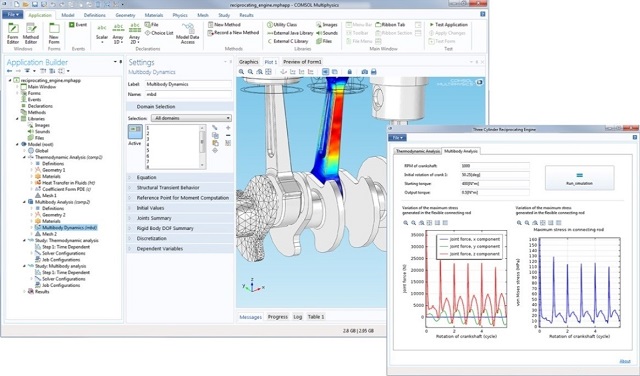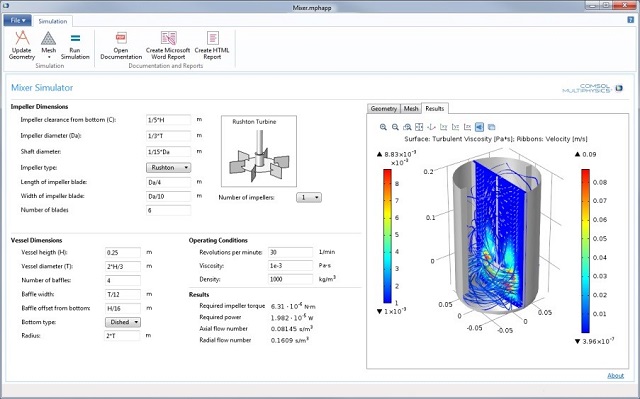COMSOL, Inc. today redefines the engineering simulation market with the release of COMSOL Multiphysics® software version 5.0, featuring extensive product updates, three new add-on products, and the new and revolutionary Application Builder.
With the Application Builder, the power and accuracy of COMSOL Multiphysics is now accessible to everyone through the use of applications. COMSOL users can now build applications for use by engineering and manufacturing departments, expanding accessibility to their expertise and to cutting-edge simulation solutions.

From simulation to application with the Application Builder desktop environment: The simulation of a three cylinder reciprocating engine (left) is turned into an application (right) where the user only needs to change design parameters and run the application to analyze the simulation results.
Introducing the Application Builder
The Application Builder empowers the design process by allowing engineers to make available an easy-to-use application based on their COMSOL Multiphysics model. Included with the Windows® operating system version of COMSOL Multiphysics® 5.0, the Application Builder provides all the tools needed to build and run simulation apps.
Any COMSOL Multiphysics model can be turned into an application with its own interface using the tools provided with the Application Builder desktop environment. Using the Form Editor, the user interface layout can be designed, while the Methods Editor is used for implementing customized commands. Based on the project at hand, engineering experts can now easily build a specialized application to share with their colleagues and customers that includes only the parameters relevant to the design of a specific device or product.
“The Application Builder is our vision for the future of simulation,” says Svante Littmarck, CEO and President of the COMSOL Group. “It brings the expertise of engineering specialists working in research and development to a greater majority of people, revolutionizing the product design process by allowing the power of multiphysics simulation to drive productivity and innovation. This is achieved by supplying those involved in the design and manufacturing process across all engineering disciplines with apps created by simulation experts.”

Build a solution as unique as your model: Turbulent mixer application, created using the
Application Builder available in COMSOL Multiphysics 5.0.
Many COMSOL users have expressed their excitement about the Application Builder. “The Application Builder is the biggest innovation yet to come from COMSOL,” says Massimo Bechis, Modeling and Simulation Specialist at Prysmian. “We estimate that by building applications for our colleagues, we would save 30-40% of the time we currently spend on calculations for them. This will improve both the way we work, and the way our colleagues work as well.”
COMSOL users currently on subscription can download COMSOL Multiphysics® 5.0, which includes the Application Builder in the Windows® OS version, at: www.comsol.com/product-download.
Three New Add-on Products in the Product Suite
COMSOL Multiphysics 5.0 also brings three new add-on products to the extensive COMSOL product suite: the Ray Optics Module, the Design Module, and LiveLink™ for Revit®. “The Ray Optics Module offers functionality that has long been anticipated by COMSOL users, and we are excited to offer the module with this release,” says Bjorn Sjodin, VP of Product Management at COMSOL, Inc.
For engineers working in application areas including building science, solar energy, and interferometers, the Ray Optics Module is an industry-leading simulation tool for analyzing systems in which the electromagnetic wavelength is much smaller than the smallest geometric detail in the model. “The Ray Optics Module is not like any other simulation software available for modeling ray optics,” says Dan Smith, COMSOL software developer. “For the first time, multiphysics simulations can now be integrated into the modeling of geometrical optics, a truly cutting-edge development for the simulation industry.” Key features of the module include the ability to compute the trajectory of rays in graded and ungraded media, and the modeling of polychromatic, unpolarized and partially coherent light.
The Design Module expands the available toolset of CAD functionalities in the COMSOL product suite. The module includes the following 3D CAD operations: loft, fillet, chamfer, midsurface, and thicken, in addition to CAD import and geometry repair functionality.
Additionally, COMSOL is proud to offer LiveLink™ for Revit®, which allows COMSOL® users to interface with the building information modeling software from Autodesk®. With LiveLink™ for Revit®, users can seamlessly synchronize a geometry between Autodesk® Revit® Architecture and COMSOL®, allowing multiphysics simulations to be brought into the architectural design workflow.
New Features and Functionalities in COMSOL 5.0
Version 5.0 also introduces numerous enhancements to the existing functionalities of COMSOL Multiphysics. New features and updates have been added to the entire product suite, which includes over 25 application-specific modules for simulating any physics in the electrical, mechanical, fluid, and chemical disciplines.
- Multiphysics – Predefined multiphysics couplings now include: Joule Heating with Thermal Expansion; Induction, Microwave, and Laser Heating; Thermal Stress; Thermoelectric and Piezoelectric Effect; Non-Isothermal Flow; Optoelectronics; Plasma Heat Source; Acoustic-Structure Interaction; Thermoacoustic-Structure and Aeroacoustic-Structure Interaction; and Acoustic-Porous and Porous-Structure Interaction.
- Geometry and Mesh – Create geometry from an imported mesh and call geometry subsequences using a linked subsequence. Additionally, faster handling of large arrays and CAD assemblies is also included.
- Optimization and Multipurpose – The Particle Tracing Module now includes accumulation of particles, erosion, and etch features. Multianalysis optimization has also been added.
- Studies and Solvers – Updates include a dramatic improvement for the simulation of CAD assemblies, support for extra dimensions, and the ability to sweep over sets of materials and user-defined functions. Improved probe-while-solving, unit support for parametric sweeps, and the ability to search for eigenfrequencies within a given interval have also been added.
- Materials and Functions – Materials can now be copied, pasted, duplicated, dragged, and dropped. Link to Global Materials using a Material Link when the same material is used in multiple components.
- Mechanical – Model geometrically nonlinear beams, nonlinear elastic materials, and elasticity in joints using the products for modeling structural mechanics. In the Heat Transfer Module, thin layer, film, fracture, and rod as well as cryogenic damage and parallelized radiation have been added. The Acoustics Module has two new methods for modeling high frequency or geometrical acoustics: Ray Acoustics and Acoustic Diffusion.
- Fluid – Create automatic pipe connections to 3D flow domains in the Pipe Flow Module. The CFD Module is expanded with two new algebraic turbulence models, as well as turbulent fans and grilles.
- Electrical – The AC/DC Module, RF Module, and Wave Optics Module now contain a frequency- and material-controlled auto mesh suggestion that offers the easy, one-click meshing of infinite elements and periodic conditions. The Plasma Module now contains interfaces for modeling equilibrium discharges.
- Chemical – The Chemical Reaction Engineering Module now contains a new Chemistry interface that can be used as a Material node for chemical reactions.
About COMSOL
COMSOL provides simulation software for product design and research to technical enterprises, research labs, and universities through 21 offices and a distributor network throughout the world. Its flagship product, COMSOL Multiphysics®, is a software environment for modeling and simulating any physics-based system and building applications.
A particular strength is its ability to account for coupled or multiphysics phenomena. Add-on products expand the simulation platform for electrical, mechanical, fluid flow, and chemical applications. Interfacing tools enable the integration of COMSOL Multiphysics® simulation with all major technical computing and CAD tools on the CAE market.